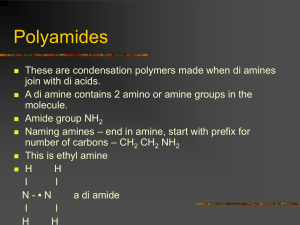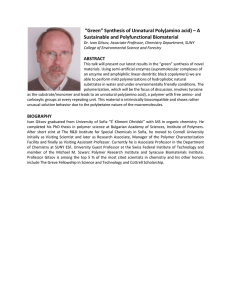Biodegradable Solid Polymeric Materials (continued)
advertisement
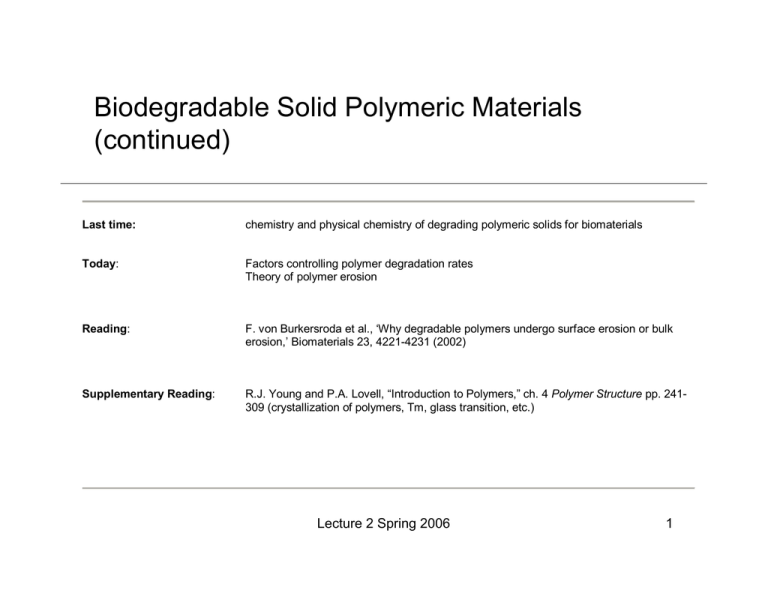
Biodegradable Solid Polymeric Materials (continued) Last time: chemistry and physical chemistry of degrading polymeric solids for biomaterials Today: Factors controlling polymer degradation rates Theory of polymer erosion Reading: F. von Burkersroda et al., ‘Why degradable polymers undergo surface erosion or bulk erosion,’ Biomaterials 23, 4221-4231 (2002) Supplementary Reading: R.J. Young and P.A. Lovell, “Introduction to Polymers,” ch. 4 Polymer Structure pp. 241309 (crystallization of polymers, Tm, glass transition, etc.) Ratner, 64-72 ‘Bioresorbable and Bioerodible Materials’ Ratner, 243-259 ‘Degradation of Materials in the Biological Environment’ Lecture 2 Spring 2006 1 Last time Lecture 2 Spring 2006 2 Last time Lecture 2 Spring 2006 3 Physical chemistry of hydrolysis: structure influences mechanism of erosion as well as overall rate • Mechanisms of dissolution: Lecture 2 Spring 2006 4 Factors controlling solid polymer degradation rates Lecture 2 Spring 2006 5 (2) Effect of polymer hydrophobicity on solid polymer erosion rate 100 degradation rate constant k (mm/hr) 0 1 2 3 4 5 6 7 1.00E-01 1.00E-02 1.00E-03 1.00E-04 poly(MSA) 72/25 poly(MSA-coC PH) Percent Mass Loss 80 1.00E+00 75/25 poly(MSA-coMStA) 50/50 poly(MSA-coC PH) 60 40 20 0 75/25 poly(MSA-coMC ) 0 500 1000 poly(C PH) 1.00E-05 1.00E-06 polyanhydride sample 1500 2000 Time (hr) 2500 3000 poly(MSA) poly(MCPH) 50:50 poly(MSA:MCPH) 40:60 poly(MSA:MCPH) 25:75 poly(MSA:MCPH) Figure by MIT OCW. 6 Lecture 2 Spring 2006 (3) Steric effects controlling polymer hydrolysis rates • Local structure • Glass transition (Tg) Lecture 2 Spring 2006 7 (4) Production of autocatalytic products • Polyesters: Lecture 2 Spring 2006 8 Hydrolysis rate theory No acid catalysis: Relationship to molecular weight (M): Lecture 2 Spring 2006 (Pitt 1987) 9 Mechanisms of hydrolysis: polyesters • acid-catalyzed hydrolysis: Lecture 2 Spring 2006 10 Mechanisms of hydrolysis: polyesters • Base-catalyzed hydrolysis: (saponification) Nucleophilic substitution at acyl carbon Lecture 2 Spring 2006 11 Rate of chain cleavage Autocatalysis of chain degradation: Lecture 2 Spring 2006 (Pitt 1987) 12 (5) Phase separation Semicrystalline polymers: 2 (or more) immiscible components: Lecture 2 Spring 2006 13 Crystallinity and Phase Separation Effects. •Zong, 1999 •Shakesheff, K.M., M. C. Davies, C. J. Roberts, S. B. J. Tendler, A. G. Shard, and A. Domb. “In Situ Atomic Force Microscophy Imaging of Polymer Degradation in an Aqueous Environment.” Langmuir 10 (1994): 4417-4419. Lecture 2 Spring 2006 14 Crystalline regions resist hydrolysis 70 φc (%) 60 50 PGA PGA-co-PLA 40 30 0 1 2 3 4 5 6 7 8 Time (week) Changes of degree of crystallinity of crystalline PGA and PGA-co -PLA samples during in vitro degradation. Figure by MIT OCW. (Zong 1999) Lecture 2 Spring 2006 15 Crystalline regions resist hydrolysis Figure removed for copyright reasons. Please see: Figure 2 in Shakesheff, K. M., M. C. Davies, C. J. Roberts, S. B. J. Tendler, A. G. Shard, and A. Domb. ”In Situ Atomic Force Microscophy Imaging of Polymer Degradation in an Aqueous Environment.” Langmuir 10 (1994): 4417-4419. (Zong 1999) Lecture 2 Spring 2006 16 (5) Phase separation: Hydrolysis in polymer blends Blends of hydrophilic and hydrophobic polymers Amorphous state - miscible Incompatible crystal lattices e.g. poly(lactide)/poly(ethylene oxide) Lecture 2 Spring 2006 17 Blends of poly(L-lactide) with poly(ethylene oxide) Remaining Mass (%) 100 95 10% 15% 20% 90 85 0 5 10 15 20 25 30 Degradation Time (Days) Mass loss of several PLLA/PEO blends during hydrolytic degradation. Lecture 2 Spring 2006 Figure by MIT OCW. 18 Constrained mass loss: PLLA-b-PEO-b-PLLA triblock copolymers Lecture 2 Spring 2006 19 Summary of factors controlling solid polymer degradation rates: Lecture 2 Spring 2006 20 Bulk vs. surface erosion: how do we predict it? Bulk erosion Surface erosion Figures removed for copyright reasons. Please see: Fig. 8(b) in Lu, L., C. A. Garcia, and A. G. Mikos. "In Vitro Degradation of Thin Poly(DL-lactic-coglycolic acid) Films.“ J Bio Med Mater Res 46 (1999): 236-44. Images of Surface Erosion removed due to copyright restrictions. Fig. 6(d) in Agrawal, C. M., and K. A. Athanasiou. “Technique to Control pH in Vicinity of Biodegrading PLA-PGA Implants.” J Biomed Mater Res 38 (1997): 105-14. Lecture 2 Spring 2006 21 Göpferich theory of polymer erosion • If polymer is initially water-insoluble, and hydrolysis is the only mechanism of degradation, then two rates dominate erosion behavior: Lecture 2 Spring 2006 22 Rate of water diffusion into polymer matrix Figure by MIT OCW. (Atkins 1997) Lecture 2 Spring 2006 23 Rate of chain cleavage t=0 t Lecture 2 Spring 2006 24 Further Reading 1. 2. 3. 4. 5. 6. 7. 8. 9. 10. 11. 12. 13. 14. 15. 16. 17. Gopferich, A. & Langer, R. Modeling of Polymer Erosion. Macromolecules 26, 4105-4112 (1993). Gopferich, A. Polymer bulk erosion. Macromolecules 30, 2598-2604 (1997). Gopferich, A. Mechanisms of polymer degradation and erosion. Biomaterials 17, 103-14 (1996). von Burkersroda, F., Schedl, L. & Gopferich, A. Why degradable polymers undergo surface erosion or bulk erosion. Biomaterials 23, 4221-31 (2002). Agrawal, C. M. & Athanasiou, K. A. Technique to control pH in vicinity of biodegrading PLA-PGA implants. J Biomed Mater Res 38, 105-14 (1997). Lu, L., Garcia, C. A. & Mikos, A. G. In vitro degradation of thin poly(DL-lactic-co-glycolic acid) films. J Biomed Mater Res 46, 236-44 (1999). Tsuji, H. & Nakahara, K. Poly(L-lactide). IX. Hydrolysis in acid media. Journal of Applied Polymer Science 86, 186-194 (2002). Atkins, P. The Elements of Physical Chemistry (W.H. Freeman, New York, 1997). Pitt, C. G., Marks, T. A. & Schindler, A. in Controlled Release of Bioactive Materials (ed. Baker, R. W.) 19-43 (Academic Press, New York, 1980). Albertsson, A. C. & Varma, I. K. in Degradable Aliphatic Polyesters 1-40 (2002). Stridsberg, K. M., Ryner, M. & Albertsson, A. C. in Degradable Aliphatic Polyesters 41-65 (2002). Barrera, D. A., Zylstra, E., Lansbury, P. T. & Langer, R. Synthesis and RGD peptide modification of a new biodegradable copolymer: poly(lactic acid-co-lysine). J. Am. Chem. Soc. 115, 11010-11011 (1993). Barrera, D. A., Zylstra, E., Lansbury, P. T. & Langer, R. Copolymerization and degradation of poly(lactic acid-colysine). Macromolecules 28, 425-432 (1995). Cook, A. D. et al. Characterization and development of RGD-peptide-modified poly(lactic acid-co-lysine) as an interactive, resorbable biomaterial. J Biomed Mater Res 35, 513-23 (1997). Ivin, K. J. Ring-opening polymerization (Elsevier, London, 1984). Burkoth, A. K. & Anseth, K. S. A review of photocrosslinked polyanhydrides: in situ forming degradable networks. Biomaterials 21, 2395-404 (2000). Burkoth, A. K., Burdick, J. & Anseth, K. S. Surface and bulk modifications to photocrosslinked polyanhydrides to control degradation behavior. J Biomed Mater Res 51, 352-9 (2000). Lecture 2 Spring 2006 25
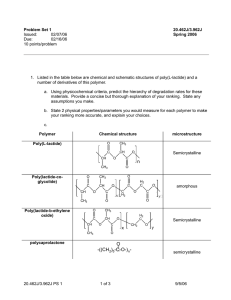
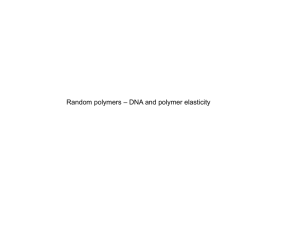

![Name: .[printed]](http://s2.studylib.net/store/data/013223452_1-16d694c84e5633632176744e9d5c5914-300x300.png)
